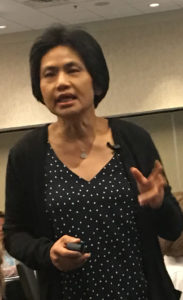How do you become the pioneer of your industry?

When we think about successful organizations, we might think of Harvard University, Home Depot, Disney World, Coca Cola or the New England Patriots. Over the years, these organizations have consistently identified ways to provide a sound product or service to their customers.
While many organizations quite often focus on competing for the same customers, the critical questions to be asked are: How do you become the pioneer of your industry? What is blue ocean strategy? How is blue ocean strategy different from benchmarking? What are some examples of the blue ocean strategy move?
On September 26-27, I attended the National Council for Workforce Education (NCWE) conference in Clearwater Beach, Fl. NCWE provides a national forum for administrators and faculty in workforce education and basic skills, as well as representatives of business, labor, military and government.
 One of the keynote speakers of the conference was Katrina Ling. Ling is a trainer, consultant, and speaker for international audiences. She works with industries to implement the blue ocean strategy to create innovative solutions that offer exceptional value and reduced cost structures. The following provides an excerpt of Ling’s speech as a vehicle to answer the preceding questions:
One of the keynote speakers of the conference was Katrina Ling. Ling is a trainer, consultant, and speaker for international audiences. She works with industries to implement the blue ocean strategy to create innovative solutions that offer exceptional value and reduced cost structures. The following provides an excerpt of Ling’s speech as a vehicle to answer the preceding questions:
Blue ocean strategy is based on extensive research of more than 150 strategic moves spanning across 30 industries over 100 years. The authors of the book, Blue Ocean Strategy (Chan Kim and Renee Mauborgne), argued that industries could flourish by creating blue oceans of uncontested market space rather than red oceans where their competitors fight for domination. The analogy is that an ocean overwhelmed with competition turns red with blood (Wikipedia).
As educators, most of you are involved in some type of strategy in your line of work. The strategy you are probably most comfortable with is the traditional competitive based strategy, noted Ling. You typically benchmark by looking at the environment and the suppliers of the industry. You might look at the curriculum of the industry and how it is offered. You are basically looking at an industry similar or different from yours. You engage in a price competition because that’s probably the only leverage you can change.
When we work to become a pioneer of our industry utilizing blue ocean strategy, we ask a different set of questions. If we are trying to educate everyone in our industry who needs to be educated, these people are called our non-customers. You have to find innovative ways to attract them to your industry. However, there might be structural barriers such as resource constraints or even your mindset that prevents non-customers from coming to your industry.
So you have to shift your thinking from what factors are preventing the non-customers from coming to your industry to how can you offer the best possible service to them. By doing the same thing over and over again, you won’t get new customers. You have to flip conventional wisdom upside down, recreate based on what the non-customers are looking for, eliminate or reduce cost, look across industries, and don’t benchmark or compete with your competitors. This is the blue ocean strategy move, noted Ling.
According to Ling, there are many examples of companies that have used blue ocean strategy. One specific example she shared was Southwest Airlines. In the transportation industry, customers have many options to meet their needs. Customers can travel by car, plane, bus or train. Using blue ocean strategy, Southwest wanted to attract customers who were typically outside of the flying industry. Southwest decided to price its tickets comparable to the cost of a bus ticket and tank of gas. This new pricing strategy was to attract families taking vacations to fly instead of driving and make the flying experience fun.
Just like Southwest, educators have to price their services and programs across industries in order to attract new customers. You can’t afford to lose customers because of structural barriers such as a customer having to wait an entire year because he or she missed a prerequisite course. This can force current and potential customers to take other alternatives or career paths for a better lifestyle. In fact, sometimes people even abolish their educational dreams because of academic constraints, noted Ling.
Taking a blue ocean strategy, Peirce College in Philadelphia realized the difficulties veterans experienced in taking courses and, subsequently, having to relocate to different locations. As a result, Peirce College implemented an online degree program where veterans could take courses from any geographical location and still progress at the same rate. This was attractive to veterans, as well as other non-customers who did not reside in Philadelphia. As part of the blue ocean strategy move, the college sold its Dean’s house to finance the cost of the online degree program, noted Ling.
Another undertaking of the blue ocean strategy move is the work of the Malaysian Government. Instead of putting people in prison and expecting them to find a job when they left prison, Malaysia hired prisoners while incarcerated. They placed them on idle land to grow crops so they could make money and have a skill once they left prison. This resulted in a cost saving for Malaysia and provided rehabilitation for inmates to become productive members of society once they were released from prison.
As proven, blue ocean strategy is an innovative way to become the pioneer of your industry. According to Ling, you can help your institution grow by flipping conventional wisdom upside down, recreating based on what the non-customers are looking for, and eliminating or reducing cost. You can also help your institution grow by looking across industries instead of benchmarking or competing with your competitors.
Dr. Ronald Holmes is a former teacher, school administrator, test developer and district superintendent. He is the author of 16 books and publisher of The Holmes Education Post, an education focused Internet newspaper. These books include How to Eradicate Hazing; How to Eradicate Cyber Bullying; How to Eradicate Schoolyard Bullying; and How to Eradicate Workplace Bullying. These books serve as a reference guide to an online anti-bullying program that provides training for all students, parents, employees, and managers. These books are also equipped with a 24 hour Web Based Reporting, Tracking, Training and Documentation System that allow individuals to report bullying incidents anonymously from the home, school, work and community.
Click on this link to see a description of all of Dr. Ronald Holmes’ books.

